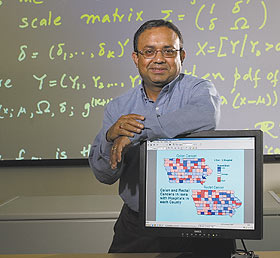  |
| HOME | THIS ISSUE | CALENDAR | GRANTS | BACK ISSUES | < BACK | NEXT > |
Researcher uses statistics to study cancer, other health issues
by Peyton Woodson Cooper - December 12, 2005 |
||||
|
Dipak Dey is an ambassador for the field of statistics. It’s an academic discipline that suffers from an identity problem, he muses. Often seen as a puzzling and abstract branch of mathematics, statistics is in fact an interdisciplinary field with an impact that is far reaching. From studying the treatment of disease to preliminary planning for natural disasters or terrorist attacks, statistics can be readily connected to nature and our daily lives. Dey, who serves as head of the statistics department in the College of Liberal Arts and Sciences, is currently using statistical applications to foster cancer prevention methods and study the cognitive development of children. Heralded as a highly prolific researcher, Dey has studied statistics for several decades and published 150 peer-reviewed publications. He is best known for his contributions in the areas of statistical decision theory and Bayesian statistics. Statistical decision theory involves the collection of data to make an educated decision about an issue. Bayesian statistics is a philosophy that combines historical knowledge about an issue with current data to forecast future trends. This fall, Dey was recognized by the UConn Alumni Association with its award for faculty excellence in research, for developing and maintaining collaborative research programs with other University departments and organizations. “Bayesian analysis is today one of the hottest areas of development,” says Jim Berger, director of the national Statistical and Applied Mathematical Sciences Institute. “Until about 15 years ago it was too difficult to routinely implement in practice. However, newer techniques, including some developed by Dr. Dey, have made it easier to do the computational aspects of the analysis.” Dey says his philosophy has always been to teach statistics through example and application. “Statistics should be taught using examples from everyday life,” he says. “From my childhood, I was interested in mathematics. Not just problem solving, but how I can apply mathematics to our surrounding world. “Take a look outside at the trees. How do they grow? How do you determine their age? Using statistical modeling, you can take one or two samples of trees and then make predictions about the age of a forest.” Dey’s stature in his field was recognized by his election as Fellow of both the American Statistical Association and the Institute of Mathematical Statistics, each of which selects only about 0.5 percent of its membership annually for this honor. “Dr. Dey has used statistics to explain nature and capture uncertainty,” says Athanasios Micheas, assistant professor of statistics at the University of Missouri-Columbia. “He has also helped statisticians to learn more about the science of the field. This leads to new scientists working to better the world.”
Dey’s earlier research initiatives were praised within the statistical community for their insight on theory and he is now receiving recognition for applying statistical knowledge to other academic disciplines. Two of Dey’s current research projects employ his trademark areas, statistical decision theory and Bayesian statistics. For the past eight years, Dey has used statistical decision theory to study colon and rectal cancer patients in 92 Iowa counties, based on data from the National Cancer Institute. Some of the counties studied are located near major cities with several hospitals; other counties are rural and may have only one – or in some cases no – nearby local hospital. Using a statistical geographic model, Dey studied the cancer survival rate by county. “I showed that if a county had access to a better health care system, people survived longer, regardless of whether their cancer was detected in the early or middle stages,” Dey says. “Our objective is to tell the politicians about our research, so that there will be some impact on the quality of health care throughout the state. We want to pressure them to create cancer facilities in areas where there is high incidence of the disease.” Using Bayesian statistics, Dey has partnered with faculty in the nutritional sciences department in the College of Agriculture and Natural Resources to study the effects of nutrients on children before and soon after birth. Dey is using longitudinal data modeling to monitor how nutrients affect the cognitive development of children. By studying a child’s sleep patterns, researchers can study mental development. The study will have significant applications in developing countries, where children often do not receive essential nutrients. Nalini Ravishanker, a professor of statistics, says collaborative discipline projects such as these help boost the general public’s understanding of the value of statistics. Statisticians can not operate in a vacuum, she says. “We need to collaborate for science to grow,” Ravishanker says. “When our discipline reaches the outside world, we can begin to try to understand how the methods and models that we have developed can be adapted to solve problems.” |
| ADVANCE HOME UCONN HOME |

